Organizational Behaviour Report: Impact on Individual/Teams
VerifiedAdded on 2023/03/16
|10
|3891
|42
Report
AI Summary
This report provides an in-depth analysis of organizational behaviour, using the British Broadcasting Corporation (BBC) as a case study. It explores the impact of organizational culture, politics, and power on individual and team performance, referencing Handy's typology of organizational culture and examining how these factors influence employee behaviour and output. The report delves into content and process theories of motivation, including Herzberg's two-factor theory and reinforcement theory, illustrating how these theories are applied within the BBC. Furthermore, it examines the factors that contribute to team effectiveness, referencing Tuckman's model of team development and Belbin's team roles. The report concludes by summarizing key concepts and philosophies of organizational behaviour, offering insights into how the BBC manages its workforce to achieve its objectives.
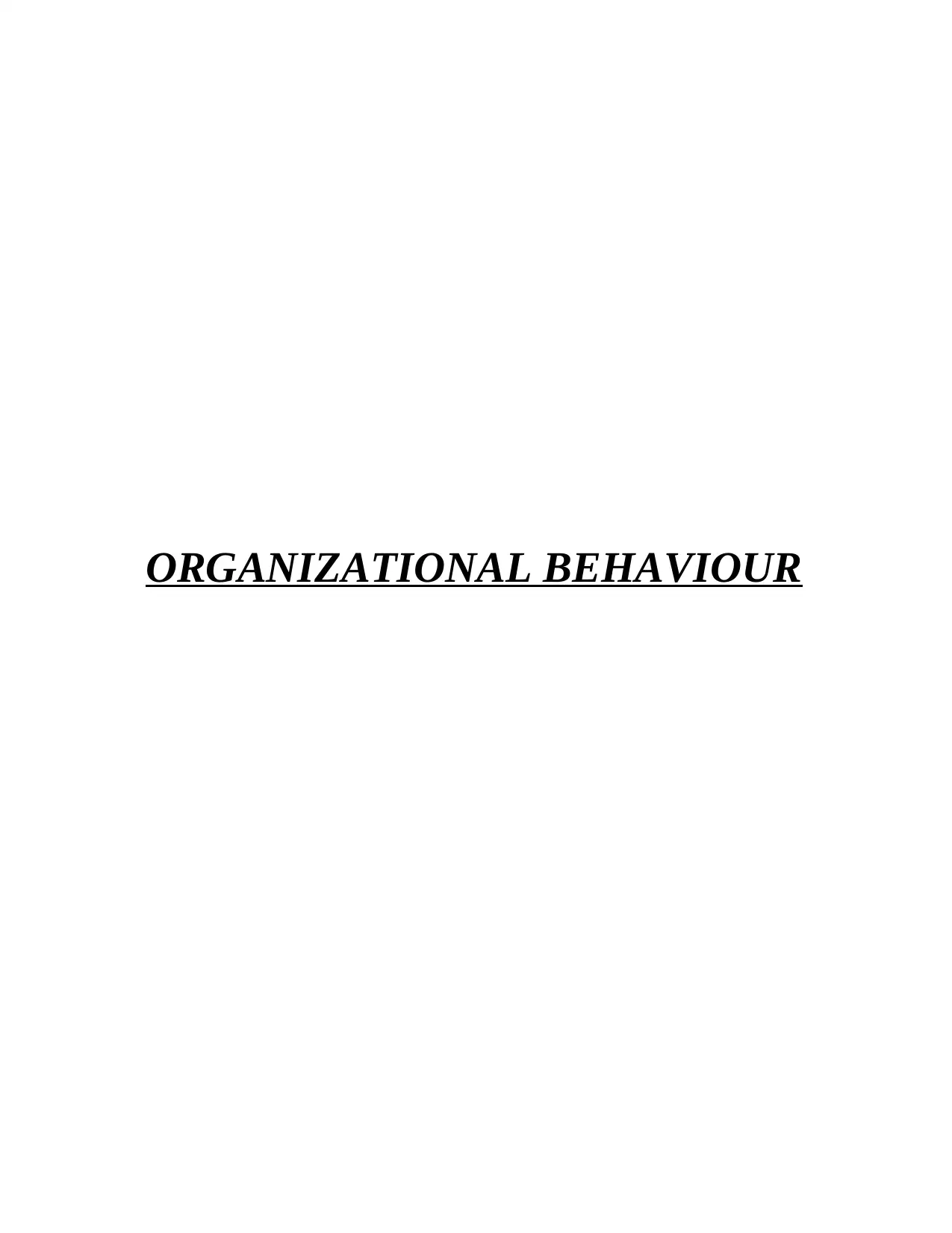
ORGANIZATIONAL BEHAVIOUR
Paraphrase This Document
Need a fresh take? Get an instant paraphrase of this document with our AI Paraphraser
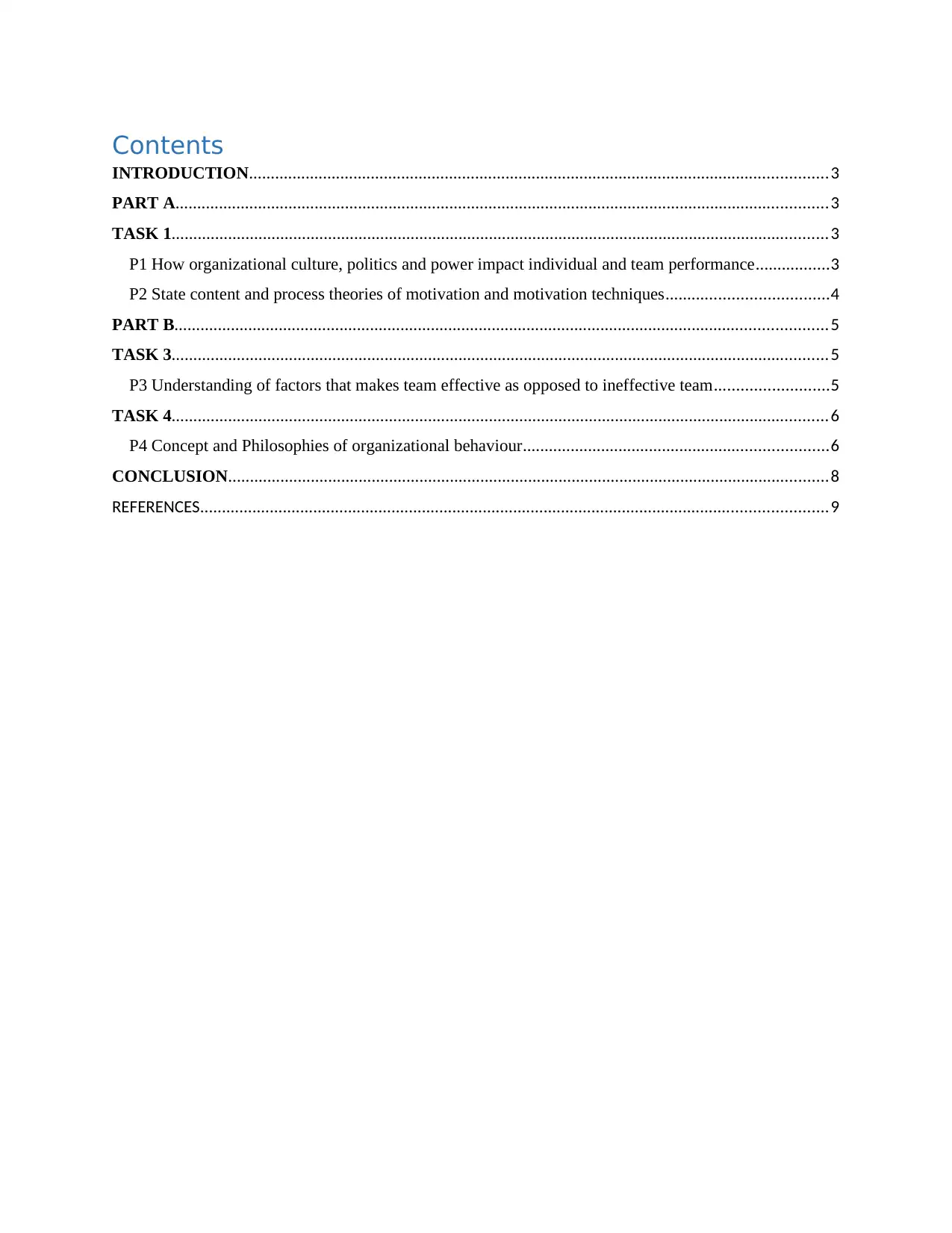
Contents
INTRODUCTION.....................................................................................................................................3
PART A......................................................................................................................................................3
TASK 1.......................................................................................................................................................3
P1 How organizational culture, politics and power impact individual and team performance.................3
P2 State content and process theories of motivation and motivation techniques.....................................4
PART B......................................................................................................................................................5
TASK 3.......................................................................................................................................................5
P3 Understanding of factors that makes team effective as opposed to ineffective team..........................5
TASK 4.......................................................................................................................................................6
P4 Concept and Philosophies of organizational behaviour......................................................................6
CONCLUSION..........................................................................................................................................8
REFERENCES................................................................................................................................................9
INTRODUCTION.....................................................................................................................................3
PART A......................................................................................................................................................3
TASK 1.......................................................................................................................................................3
P1 How organizational culture, politics and power impact individual and team performance.................3
P2 State content and process theories of motivation and motivation techniques.....................................4
PART B......................................................................................................................................................5
TASK 3.......................................................................................................................................................5
P3 Understanding of factors that makes team effective as opposed to ineffective team..........................5
TASK 4.......................................................................................................................................................6
P4 Concept and Philosophies of organizational behaviour......................................................................6
CONCLUSION..........................................................................................................................................8
REFERENCES................................................................................................................................................9
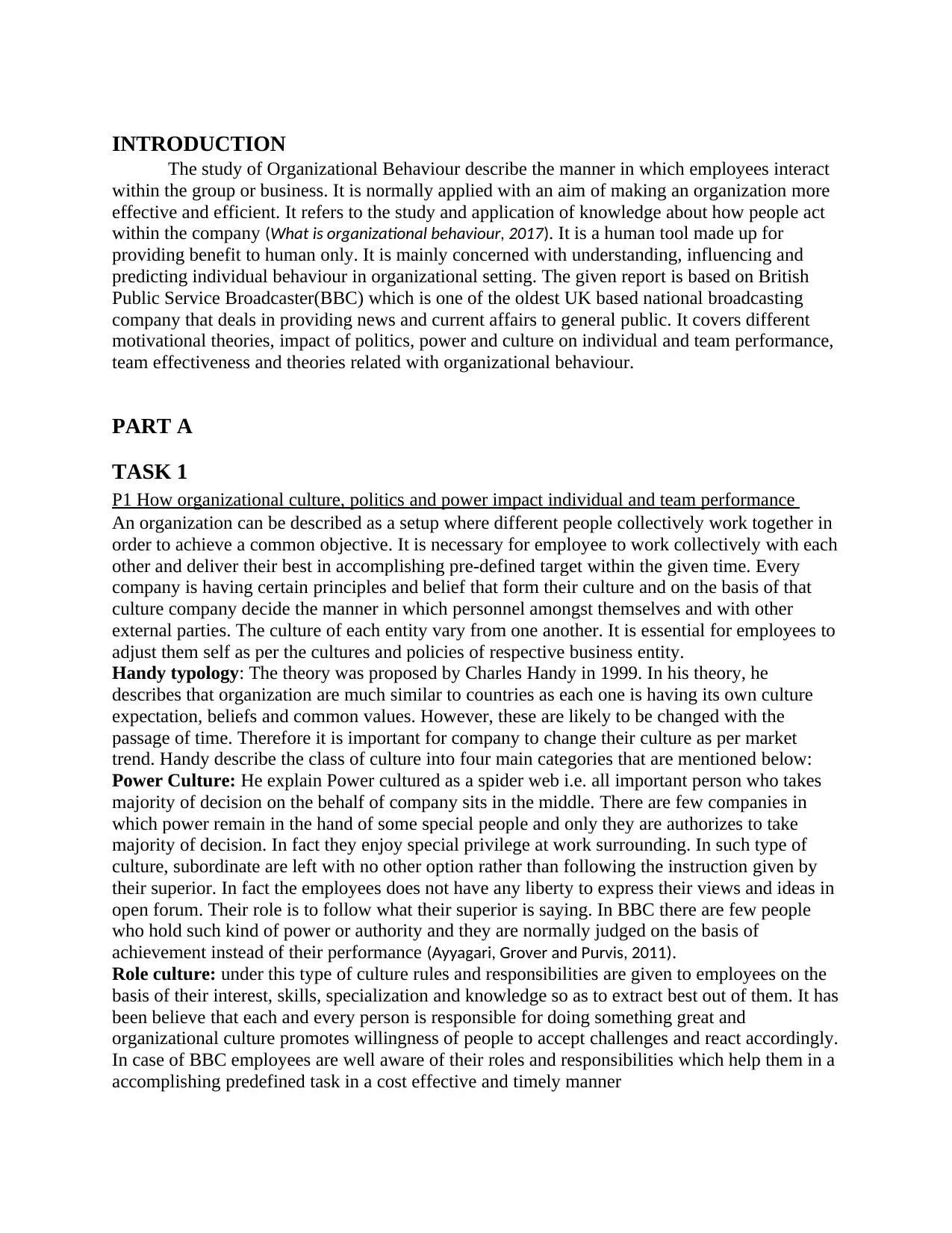
INTRODUCTION
The study of Organizational Behaviour describe the manner in which employees interact
within the group or business. It is normally applied with an aim of making an organization more
effective and efficient. It refers to the study and application of knowledge about how people act
within the company (What is organizational behaviour, 2017). It is a human tool made up for
providing benefit to human only. It is mainly concerned with understanding, influencing and
predicting individual behaviour in organizational setting. The given report is based on British
Public Service Broadcaster(BBC) which is one of the oldest UK based national broadcasting
company that deals in providing news and current affairs to general public. It covers different
motivational theories, impact of politics, power and culture on individual and team performance,
team effectiveness and theories related with organizational behaviour.
PART A
TASK 1
P1 How organizational culture, politics and power impact individual and team performance
An organization can be described as a setup where different people collectively work together in
order to achieve a common objective. It is necessary for employee to work collectively with each
other and deliver their best in accomplishing pre-defined target within the given time. Every
company is having certain principles and belief that form their culture and on the basis of that
culture company decide the manner in which personnel amongst themselves and with other
external parties. The culture of each entity vary from one another. It is essential for employees to
adjust them self as per the cultures and policies of respective business entity.
Handy typology: The theory was proposed by Charles Handy in 1999. In his theory, he
describes that organization are much similar to countries as each one is having its own culture
expectation, beliefs and common values. However, these are likely to be changed with the
passage of time. Therefore it is important for company to change their culture as per market
trend. Handy describe the class of culture into four main categories that are mentioned below:
Power Culture: He explain Power cultured as a spider web i.e. all important person who takes
majority of decision on the behalf of company sits in the middle. There are few companies in
which power remain in the hand of some special people and only they are authorizes to take
majority of decision. In fact they enjoy special privilege at work surrounding. In such type of
culture, subordinate are left with no other option rather than following the instruction given by
their superior. In fact the employees does not have any liberty to express their views and ideas in
open forum. Their role is to follow what their superior is saying. In BBC there are few people
who hold such kind of power or authority and they are normally judged on the basis of
achievement instead of their performance (Ayyagari, Grover and Purvis, 2011).
Role culture: under this type of culture rules and responsibilities are given to employees on the
basis of their interest, skills, specialization and knowledge so as to extract best out of them. It has
been believe that each and every person is responsible for doing something great and
organizational culture promotes willingness of people to accept challenges and react accordingly.
In case of BBC employees are well aware of their roles and responsibilities which help them in a
accomplishing predefined task in a cost effective and timely manner
The study of Organizational Behaviour describe the manner in which employees interact
within the group or business. It is normally applied with an aim of making an organization more
effective and efficient. It refers to the study and application of knowledge about how people act
within the company (What is organizational behaviour, 2017). It is a human tool made up for
providing benefit to human only. It is mainly concerned with understanding, influencing and
predicting individual behaviour in organizational setting. The given report is based on British
Public Service Broadcaster(BBC) which is one of the oldest UK based national broadcasting
company that deals in providing news and current affairs to general public. It covers different
motivational theories, impact of politics, power and culture on individual and team performance,
team effectiveness and theories related with organizational behaviour.
PART A
TASK 1
P1 How organizational culture, politics and power impact individual and team performance
An organization can be described as a setup where different people collectively work together in
order to achieve a common objective. It is necessary for employee to work collectively with each
other and deliver their best in accomplishing pre-defined target within the given time. Every
company is having certain principles and belief that form their culture and on the basis of that
culture company decide the manner in which personnel amongst themselves and with other
external parties. The culture of each entity vary from one another. It is essential for employees to
adjust them self as per the cultures and policies of respective business entity.
Handy typology: The theory was proposed by Charles Handy in 1999. In his theory, he
describes that organization are much similar to countries as each one is having its own culture
expectation, beliefs and common values. However, these are likely to be changed with the
passage of time. Therefore it is important for company to change their culture as per market
trend. Handy describe the class of culture into four main categories that are mentioned below:
Power Culture: He explain Power cultured as a spider web i.e. all important person who takes
majority of decision on the behalf of company sits in the middle. There are few companies in
which power remain in the hand of some special people and only they are authorizes to take
majority of decision. In fact they enjoy special privilege at work surrounding. In such type of
culture, subordinate are left with no other option rather than following the instruction given by
their superior. In fact the employees does not have any liberty to express their views and ideas in
open forum. Their role is to follow what their superior is saying. In BBC there are few people
who hold such kind of power or authority and they are normally judged on the basis of
achievement instead of their performance (Ayyagari, Grover and Purvis, 2011).
Role culture: under this type of culture rules and responsibilities are given to employees on the
basis of their interest, skills, specialization and knowledge so as to extract best out of them. It has
been believe that each and every person is responsible for doing something great and
organizational culture promotes willingness of people to accept challenges and react accordingly.
In case of BBC employees are well aware of their roles and responsibilities which help them in a
accomplishing predefined task in a cost effective and timely manner
⊘ This is a preview!⊘
Do you want full access?
Subscribe today to unlock all pages.

Trusted by 1+ million students worldwide
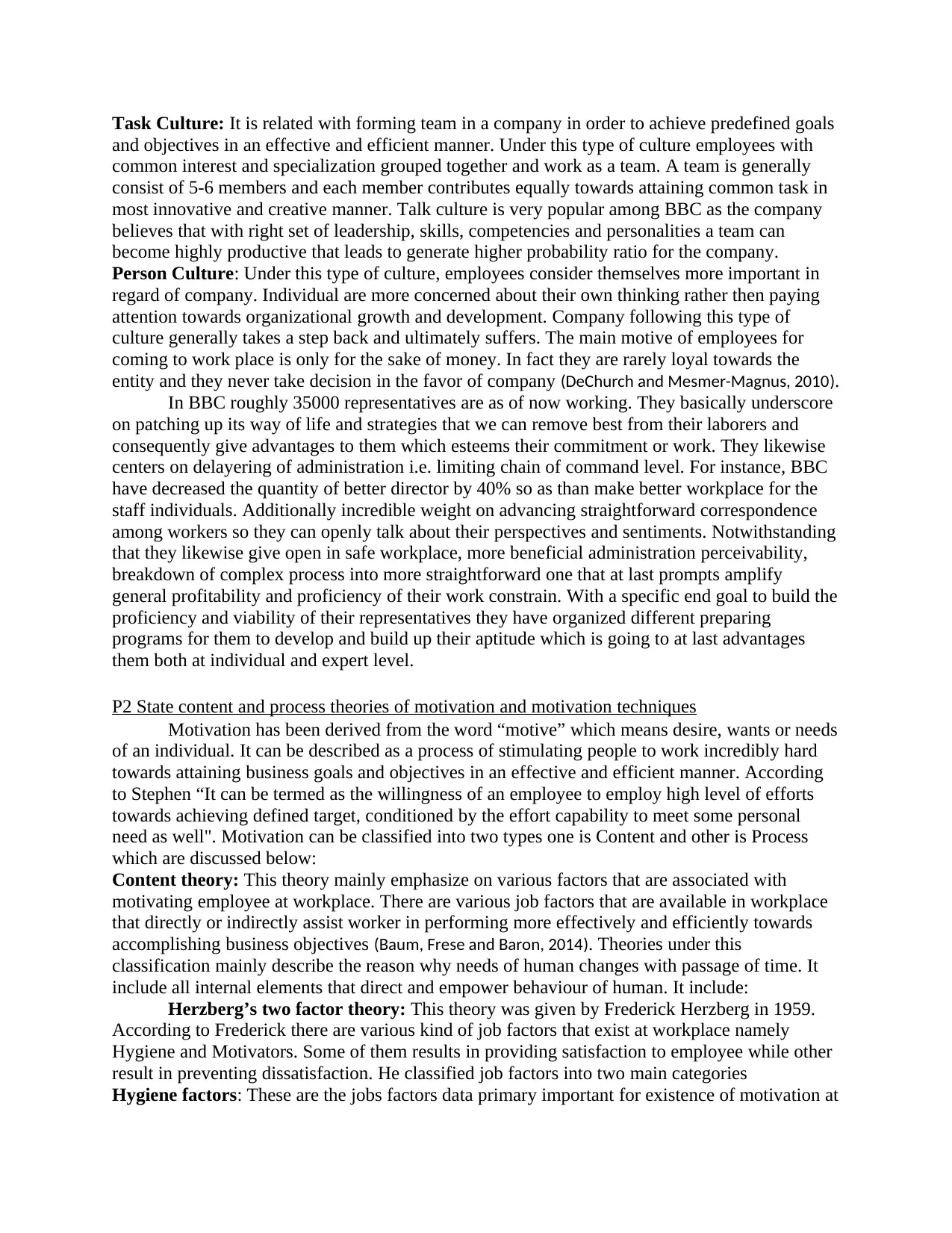
Task Culture: It is related with forming team in a company in order to achieve predefined goals
and objectives in an effective and efficient manner. Under this type of culture employees with
common interest and specialization grouped together and work as a team. A team is generally
consist of 5-6 members and each member contributes equally towards attaining common task in
most innovative and creative manner. Talk culture is very popular among BBC as the company
believes that with right set of leadership, skills, competencies and personalities a team can
become highly productive that leads to generate higher probability ratio for the company.
Person Culture: Under this type of culture, employees consider themselves more important in
regard of company. Individual are more concerned about their own thinking rather then paying
attention towards organizational growth and development. Company following this type of
culture generally takes a step back and ultimately suffers. The main motive of employees for
coming to work place is only for the sake of money. In fact they are rarely loyal towards the
entity and they never take decision in the favor of company (DeChurch and Mesmer-Magnus, 2010).
In BBC roughly 35000 representatives are as of now working. They basically underscore
on patching up its way of life and strategies that we can remove best from their laborers and
consequently give advantages to them which esteems their commitment or work. They likewise
centers on delayering of administration i.e. limiting chain of command level. For instance, BBC
have decreased the quantity of better director by 40% so as than make better workplace for the
staff individuals. Additionally incredible weight on advancing straightforward correspondence
among workers so they can openly talk about their perspectives and sentiments. Notwithstanding
that they likewise give open in safe workplace, more beneficial administration perceivability,
breakdown of complex process into more straightforward one that at last prompts amplify
general profitability and proficiency of their work constrain. With a specific end goal to build the
proficiency and viability of their representatives they have organized different preparing
programs for them to develop and build up their aptitude which is going to at last advantages
them both at individual and expert level.
P2 State content and process theories of motivation and motivation techniques
Motivation has been derived from the word “motive” which means desire, wants or needs
of an individual. It can be described as a process of stimulating people to work incredibly hard
towards attaining business goals and objectives in an effective and efficient manner. According
to Stephen “It can be termed as the willingness of an employee to employ high level of efforts
towards achieving defined target, conditioned by the effort capability to meet some personal
need as well". Motivation can be classified into two types one is Content and other is Process
which are discussed below:
Content theory: This theory mainly emphasize on various factors that are associated with
motivating employee at workplace. There are various job factors that are available in workplace
that directly or indirectly assist worker in performing more effectively and efficiently towards
accomplishing business objectives (Baum, Frese and Baron, 2014). Theories under this
classification mainly describe the reason why needs of human changes with passage of time. It
include all internal elements that direct and empower behaviour of human. It include:
Herzberg’s two factor theory: This theory was given by Frederick Herzberg in 1959.
According to Frederick there are various kind of job factors that exist at workplace namely
Hygiene and Motivators. Some of them results in providing satisfaction to employee while other
result in preventing dissatisfaction. He classified job factors into two main categories
Hygiene factors: These are the jobs factors data primary important for existence of motivation at
and objectives in an effective and efficient manner. Under this type of culture employees with
common interest and specialization grouped together and work as a team. A team is generally
consist of 5-6 members and each member contributes equally towards attaining common task in
most innovative and creative manner. Talk culture is very popular among BBC as the company
believes that with right set of leadership, skills, competencies and personalities a team can
become highly productive that leads to generate higher probability ratio for the company.
Person Culture: Under this type of culture, employees consider themselves more important in
regard of company. Individual are more concerned about their own thinking rather then paying
attention towards organizational growth and development. Company following this type of
culture generally takes a step back and ultimately suffers. The main motive of employees for
coming to work place is only for the sake of money. In fact they are rarely loyal towards the
entity and they never take decision in the favor of company (DeChurch and Mesmer-Magnus, 2010).
In BBC roughly 35000 representatives are as of now working. They basically underscore
on patching up its way of life and strategies that we can remove best from their laborers and
consequently give advantages to them which esteems their commitment or work. They likewise
centers on delayering of administration i.e. limiting chain of command level. For instance, BBC
have decreased the quantity of better director by 40% so as than make better workplace for the
staff individuals. Additionally incredible weight on advancing straightforward correspondence
among workers so they can openly talk about their perspectives and sentiments. Notwithstanding
that they likewise give open in safe workplace, more beneficial administration perceivability,
breakdown of complex process into more straightforward one that at last prompts amplify
general profitability and proficiency of their work constrain. With a specific end goal to build the
proficiency and viability of their representatives they have organized different preparing
programs for them to develop and build up their aptitude which is going to at last advantages
them both at individual and expert level.
P2 State content and process theories of motivation and motivation techniques
Motivation has been derived from the word “motive” which means desire, wants or needs
of an individual. It can be described as a process of stimulating people to work incredibly hard
towards attaining business goals and objectives in an effective and efficient manner. According
to Stephen “It can be termed as the willingness of an employee to employ high level of efforts
towards achieving defined target, conditioned by the effort capability to meet some personal
need as well". Motivation can be classified into two types one is Content and other is Process
which are discussed below:
Content theory: This theory mainly emphasize on various factors that are associated with
motivating employee at workplace. There are various job factors that are available in workplace
that directly or indirectly assist worker in performing more effectively and efficiently towards
accomplishing business objectives (Baum, Frese and Baron, 2014). Theories under this
classification mainly describe the reason why needs of human changes with passage of time. It
include all internal elements that direct and empower behaviour of human. It include:
Herzberg’s two factor theory: This theory was given by Frederick Herzberg in 1959.
According to Frederick there are various kind of job factors that exist at workplace namely
Hygiene and Motivators. Some of them results in providing satisfaction to employee while other
result in preventing dissatisfaction. He classified job factors into two main categories
Hygiene factors: These are the jobs factors data primary important for existence of motivation at
Paraphrase This Document
Need a fresh take? Get an instant paraphrase of this document with our AI Paraphraser
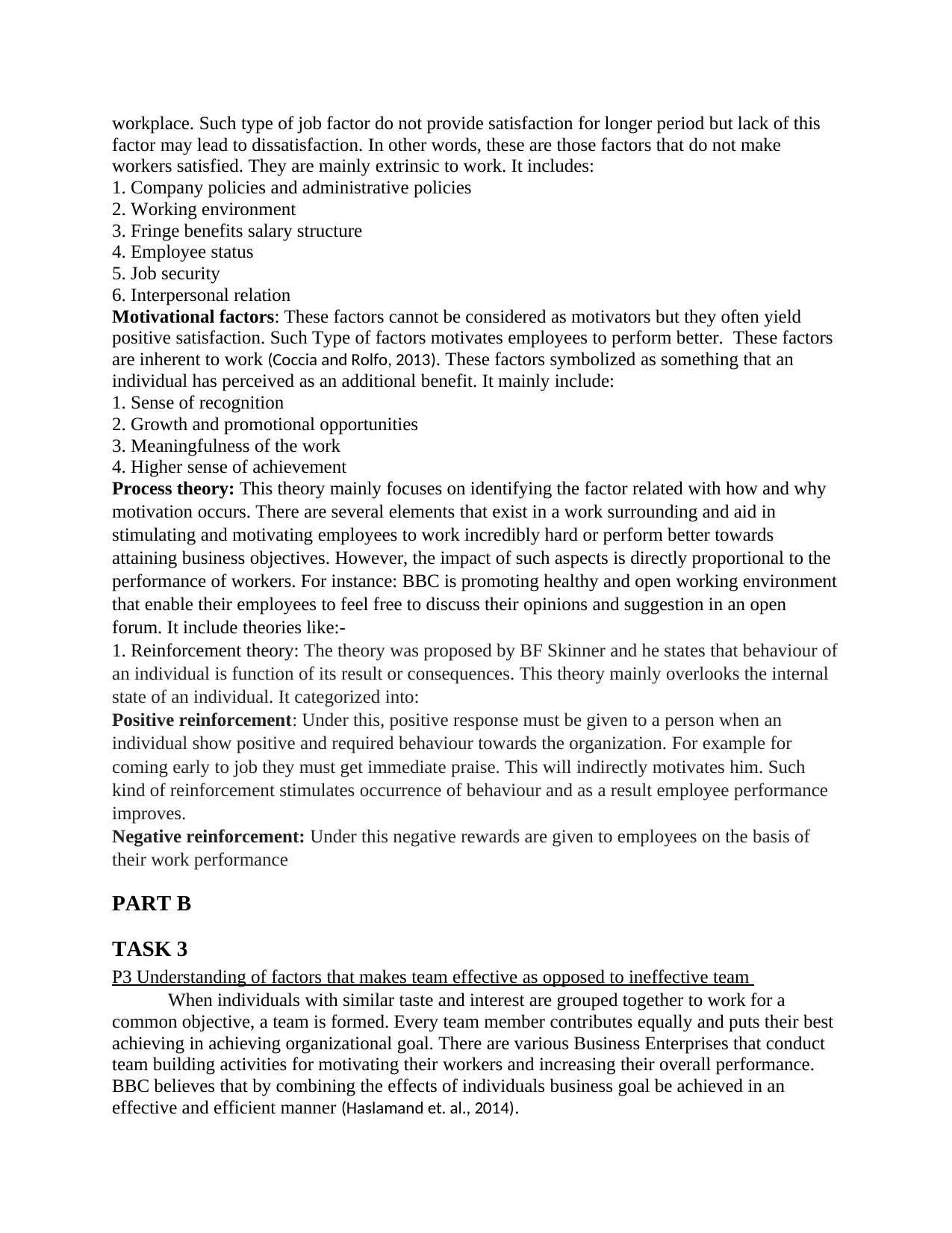
workplace. Such type of job factor do not provide satisfaction for longer period but lack of this
factor may lead to dissatisfaction. In other words, these are those factors that do not make
workers satisfied. They are mainly extrinsic to work. It includes:
1. Company policies and administrative policies
2. Working environment
3. Fringe benefits salary structure
4. Employee status
5. Job security
6. Interpersonal relation
Motivational factors: These factors cannot be considered as motivators but they often yield
positive satisfaction. Such Type of factors motivates employees to perform better. These factors
are inherent to work (Coccia and Rolfo, 2013). These factors symbolized as something that an
individual has perceived as an additional benefit. It mainly include:
1. Sense of recognition
2. Growth and promotional opportunities
3. Meaningfulness of the work
4. Higher sense of achievement
Process theory: This theory mainly focuses on identifying the factor related with how and why
motivation occurs. There are several elements that exist in a work surrounding and aid in
stimulating and motivating employees to work incredibly hard or perform better towards
attaining business objectives. However, the impact of such aspects is directly proportional to the
performance of workers. For instance: BBC is promoting healthy and open working environment
that enable their employees to feel free to discuss their opinions and suggestion in an open
forum. It include theories like:-
1. Reinforcement theory: The theory was proposed by BF Skinner and he states that behaviour of
an individual is function of its result or consequences. This theory mainly overlooks the internal
state of an individual. It categorized into:
Positive reinforcement: Under this, positive response must be given to a person when an
individual show positive and required behaviour towards the organization. For example for
coming early to job they must get immediate praise. This will indirectly motivates him. Such
kind of reinforcement stimulates occurrence of behaviour and as a result employee performance
improves.
Negative reinforcement: Under this negative rewards are given to employees on the basis of
their work performance
PART B
TASK 3
P3 Understanding of factors that makes team effective as opposed to ineffective team
When individuals with similar taste and interest are grouped together to work for a
common objective, a team is formed. Every team member contributes equally and puts their best
achieving in achieving organizational goal. There are various Business Enterprises that conduct
team building activities for motivating their workers and increasing their overall performance.
BBC believes that by combining the effects of individuals business goal be achieved in an
effective and efficient manner (Haslamand et. al., 2014).
factor may lead to dissatisfaction. In other words, these are those factors that do not make
workers satisfied. They are mainly extrinsic to work. It includes:
1. Company policies and administrative policies
2. Working environment
3. Fringe benefits salary structure
4. Employee status
5. Job security
6. Interpersonal relation
Motivational factors: These factors cannot be considered as motivators but they often yield
positive satisfaction. Such Type of factors motivates employees to perform better. These factors
are inherent to work (Coccia and Rolfo, 2013). These factors symbolized as something that an
individual has perceived as an additional benefit. It mainly include:
1. Sense of recognition
2. Growth and promotional opportunities
3. Meaningfulness of the work
4. Higher sense of achievement
Process theory: This theory mainly focuses on identifying the factor related with how and why
motivation occurs. There are several elements that exist in a work surrounding and aid in
stimulating and motivating employees to work incredibly hard or perform better towards
attaining business objectives. However, the impact of such aspects is directly proportional to the
performance of workers. For instance: BBC is promoting healthy and open working environment
that enable their employees to feel free to discuss their opinions and suggestion in an open
forum. It include theories like:-
1. Reinforcement theory: The theory was proposed by BF Skinner and he states that behaviour of
an individual is function of its result or consequences. This theory mainly overlooks the internal
state of an individual. It categorized into:
Positive reinforcement: Under this, positive response must be given to a person when an
individual show positive and required behaviour towards the organization. For example for
coming early to job they must get immediate praise. This will indirectly motivates him. Such
kind of reinforcement stimulates occurrence of behaviour and as a result employee performance
improves.
Negative reinforcement: Under this negative rewards are given to employees on the basis of
their work performance
PART B
TASK 3
P3 Understanding of factors that makes team effective as opposed to ineffective team
When individuals with similar taste and interest are grouped together to work for a
common objective, a team is formed. Every team member contributes equally and puts their best
achieving in achieving organizational goal. There are various Business Enterprises that conduct
team building activities for motivating their workers and increasing their overall performance.
BBC believes that by combining the effects of individuals business goal be achieved in an
effective and efficient manner (Haslamand et. al., 2014).
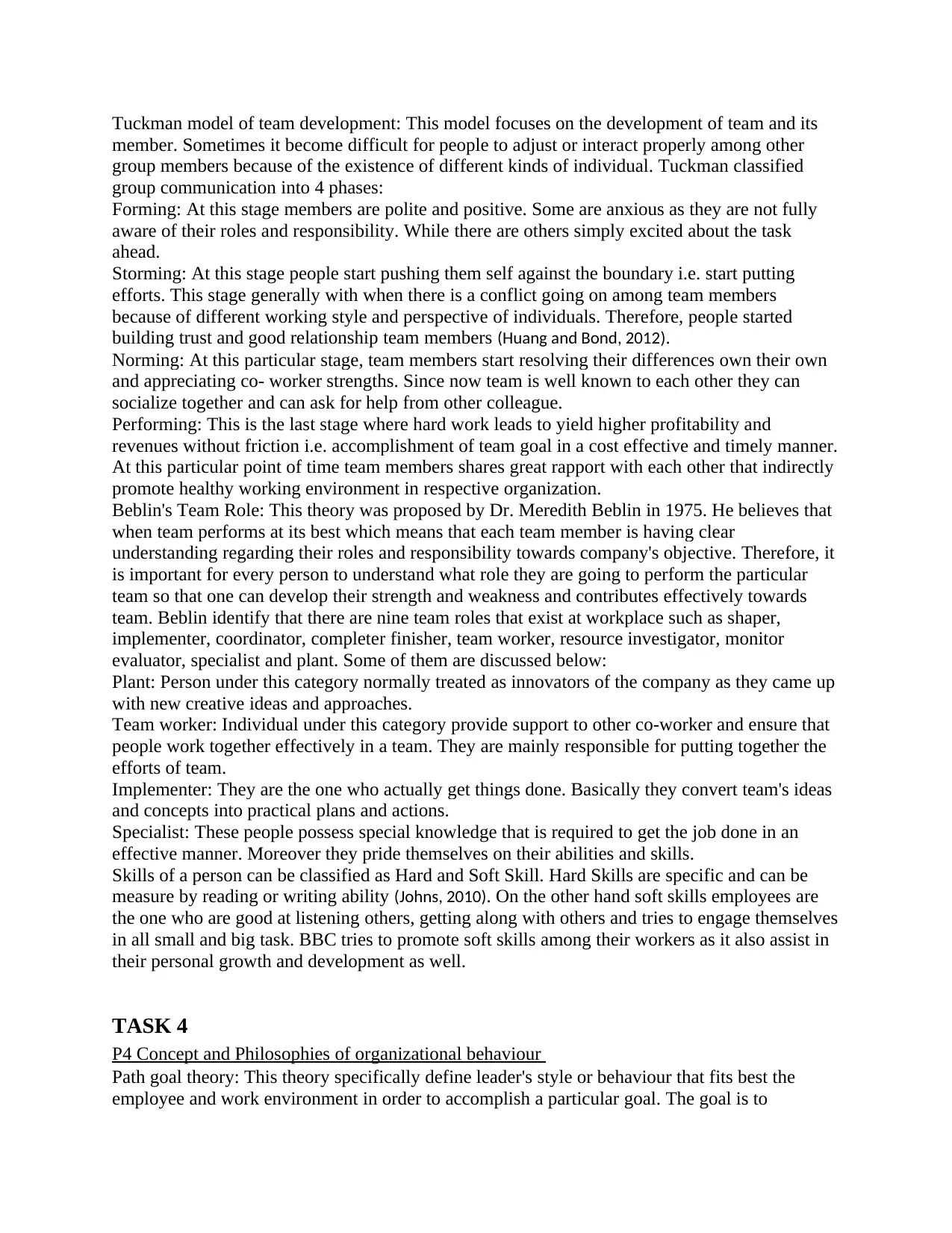
Tuckman model of team development: This model focuses on the development of team and its
member. Sometimes it become difficult for people to adjust or interact properly among other
group members because of the existence of different kinds of individual. Tuckman classified
group communication into 4 phases:
Forming: At this stage members are polite and positive. Some are anxious as they are not fully
aware of their roles and responsibility. While there are others simply excited about the task
ahead.
Storming: At this stage people start pushing them self against the boundary i.e. start putting
efforts. This stage generally with when there is a conflict going on among team members
because of different working style and perspective of individuals. Therefore, people started
building trust and good relationship team members (Huang and Bond, 2012).
Norming: At this particular stage, team members start resolving their differences own their own
and appreciating co- worker strengths. Since now team is well known to each other they can
socialize together and can ask for help from other colleague.
Performing: This is the last stage where hard work leads to yield higher profitability and
revenues without friction i.e. accomplishment of team goal in a cost effective and timely manner.
At this particular point of time team members shares great rapport with each other that indirectly
promote healthy working environment in respective organization.
Beblin's Team Role: This theory was proposed by Dr. Meredith Beblin in 1975. He believes that
when team performs at its best which means that each team member is having clear
understanding regarding their roles and responsibility towards company's objective. Therefore, it
is important for every person to understand what role they are going to perform the particular
team so that one can develop their strength and weakness and contributes effectively towards
team. Beblin identify that there are nine team roles that exist at workplace such as shaper,
implementer, coordinator, completer finisher, team worker, resource investigator, monitor
evaluator, specialist and plant. Some of them are discussed below:
Plant: Person under this category normally treated as innovators of the company as they came up
with new creative ideas and approaches.
Team worker: Individual under this category provide support to other co-worker and ensure that
people work together effectively in a team. They are mainly responsible for putting together the
efforts of team.
Implementer: They are the one who actually get things done. Basically they convert team's ideas
and concepts into practical plans and actions.
Specialist: These people possess special knowledge that is required to get the job done in an
effective manner. Moreover they pride themselves on their abilities and skills.
Skills of a person can be classified as Hard and Soft Skill. Hard Skills are specific and can be
measure by reading or writing ability (Johns, 2010). On the other hand soft skills employees are
the one who are good at listening others, getting along with others and tries to engage themselves
in all small and big task. BBC tries to promote soft skills among their workers as it also assist in
their personal growth and development as well.
TASK 4
P4 Concept and Philosophies of organizational behaviour
Path goal theory: This theory specifically define leader's style or behaviour that fits best the
employee and work environment in order to accomplish a particular goal. The goal is to
member. Sometimes it become difficult for people to adjust or interact properly among other
group members because of the existence of different kinds of individual. Tuckman classified
group communication into 4 phases:
Forming: At this stage members are polite and positive. Some are anxious as they are not fully
aware of their roles and responsibility. While there are others simply excited about the task
ahead.
Storming: At this stage people start pushing them self against the boundary i.e. start putting
efforts. This stage generally with when there is a conflict going on among team members
because of different working style and perspective of individuals. Therefore, people started
building trust and good relationship team members (Huang and Bond, 2012).
Norming: At this particular stage, team members start resolving their differences own their own
and appreciating co- worker strengths. Since now team is well known to each other they can
socialize together and can ask for help from other colleague.
Performing: This is the last stage where hard work leads to yield higher profitability and
revenues without friction i.e. accomplishment of team goal in a cost effective and timely manner.
At this particular point of time team members shares great rapport with each other that indirectly
promote healthy working environment in respective organization.
Beblin's Team Role: This theory was proposed by Dr. Meredith Beblin in 1975. He believes that
when team performs at its best which means that each team member is having clear
understanding regarding their roles and responsibility towards company's objective. Therefore, it
is important for every person to understand what role they are going to perform the particular
team so that one can develop their strength and weakness and contributes effectively towards
team. Beblin identify that there are nine team roles that exist at workplace such as shaper,
implementer, coordinator, completer finisher, team worker, resource investigator, monitor
evaluator, specialist and plant. Some of them are discussed below:
Plant: Person under this category normally treated as innovators of the company as they came up
with new creative ideas and approaches.
Team worker: Individual under this category provide support to other co-worker and ensure that
people work together effectively in a team. They are mainly responsible for putting together the
efforts of team.
Implementer: They are the one who actually get things done. Basically they convert team's ideas
and concepts into practical plans and actions.
Specialist: These people possess special knowledge that is required to get the job done in an
effective manner. Moreover they pride themselves on their abilities and skills.
Skills of a person can be classified as Hard and Soft Skill. Hard Skills are specific and can be
measure by reading or writing ability (Johns, 2010). On the other hand soft skills employees are
the one who are good at listening others, getting along with others and tries to engage themselves
in all small and big task. BBC tries to promote soft skills among their workers as it also assist in
their personal growth and development as well.
TASK 4
P4 Concept and Philosophies of organizational behaviour
Path goal theory: This theory specifically define leader's style or behaviour that fits best the
employee and work environment in order to accomplish a particular goal. The goal is to
⊘ This is a preview!⊘
Do you want full access?
Subscribe today to unlock all pages.

Trusted by 1+ million students worldwide
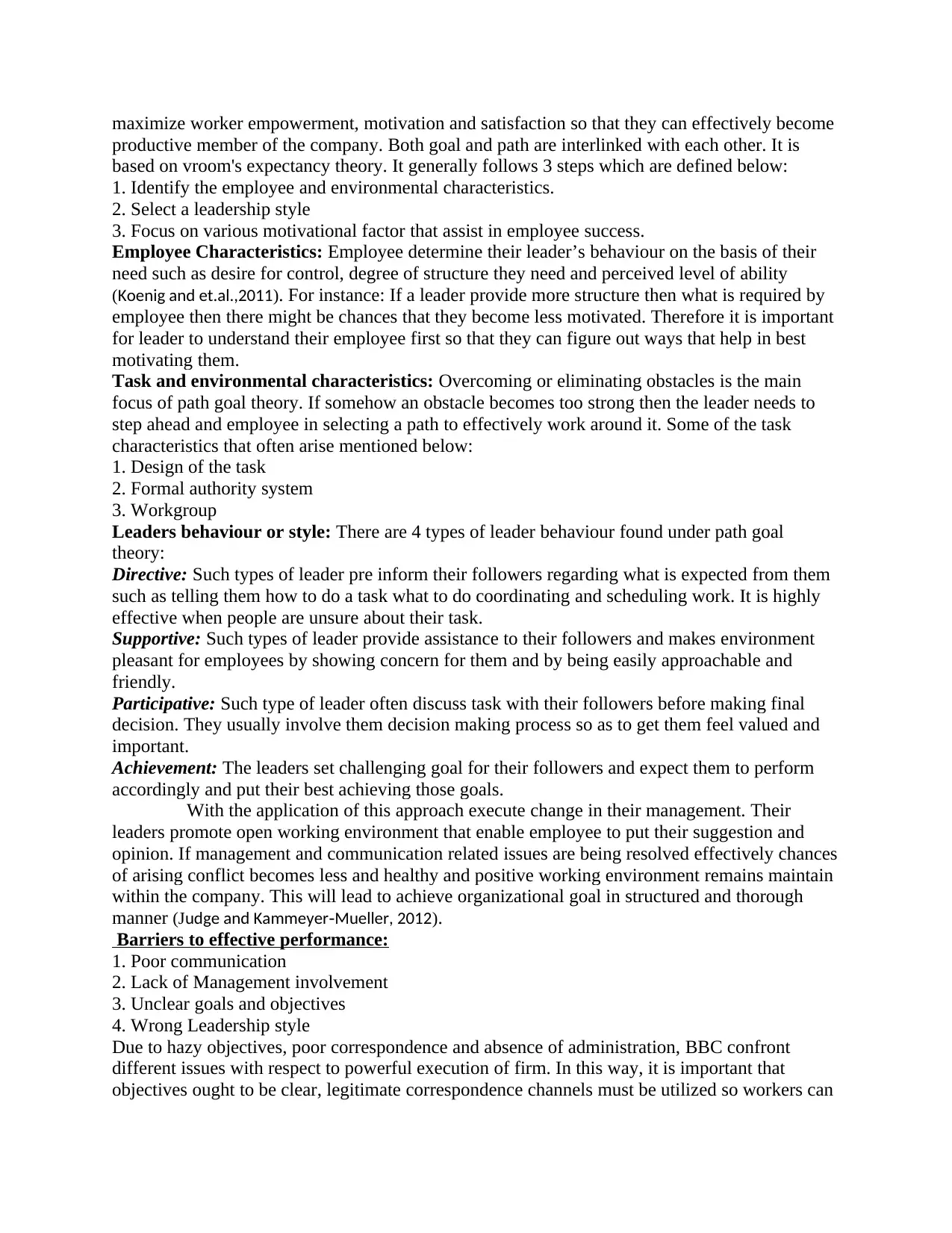
maximize worker empowerment, motivation and satisfaction so that they can effectively become
productive member of the company. Both goal and path are interlinked with each other. It is
based on vroom's expectancy theory. It generally follows 3 steps which are defined below:
1. Identify the employee and environmental characteristics.
2. Select a leadership style
3. Focus on various motivational factor that assist in employee success.
Employee Characteristics: Employee determine their leader’s behaviour on the basis of their
need such as desire for control, degree of structure they need and perceived level of ability
(Koenig and et.al.,2011). For instance: If a leader provide more structure then what is required by
employee then there might be chances that they become less motivated. Therefore it is important
for leader to understand their employee first so that they can figure out ways that help in best
motivating them.
Task and environmental characteristics: Overcoming or eliminating obstacles is the main
focus of path goal theory. If somehow an obstacle becomes too strong then the leader needs to
step ahead and employee in selecting a path to effectively work around it. Some of the task
characteristics that often arise mentioned below:
1. Design of the task
2. Formal authority system
3. Workgroup
Leaders behaviour or style: There are 4 types of leader behaviour found under path goal
theory:
Directive: Such types of leader pre inform their followers regarding what is expected from them
such as telling them how to do a task what to do coordinating and scheduling work. It is highly
effective when people are unsure about their task.
Supportive: Such types of leader provide assistance to their followers and makes environment
pleasant for employees by showing concern for them and by being easily approachable and
friendly.
Participative: Such type of leader often discuss task with their followers before making final
decision. They usually involve them decision making process so as to get them feel valued and
important.
Achievement: The leaders set challenging goal for their followers and expect them to perform
accordingly and put their best achieving those goals.
With the application of this approach execute change in their management. Their
leaders promote open working environment that enable employee to put their suggestion and
opinion. If management and communication related issues are being resolved effectively chances
of arising conflict becomes less and healthy and positive working environment remains maintain
within the company. This will lead to achieve organizational goal in structured and thorough
manner (Judge and Kammeyer Mueller, 2012‐ ).
Barriers to effective performance:
1. Poor communication
2. Lack of Management involvement
3. Unclear goals and objectives
4. Wrong Leadership style
Due to hazy objectives, poor correspondence and absence of administration, BBC confront
different issues with respect to powerful execution of firm. In this way, it is important that
objectives ought to be clear, legitimate correspondence channels must be utilized so workers can
productive member of the company. Both goal and path are interlinked with each other. It is
based on vroom's expectancy theory. It generally follows 3 steps which are defined below:
1. Identify the employee and environmental characteristics.
2. Select a leadership style
3. Focus on various motivational factor that assist in employee success.
Employee Characteristics: Employee determine their leader’s behaviour on the basis of their
need such as desire for control, degree of structure they need and perceived level of ability
(Koenig and et.al.,2011). For instance: If a leader provide more structure then what is required by
employee then there might be chances that they become less motivated. Therefore it is important
for leader to understand their employee first so that they can figure out ways that help in best
motivating them.
Task and environmental characteristics: Overcoming or eliminating obstacles is the main
focus of path goal theory. If somehow an obstacle becomes too strong then the leader needs to
step ahead and employee in selecting a path to effectively work around it. Some of the task
characteristics that often arise mentioned below:
1. Design of the task
2. Formal authority system
3. Workgroup
Leaders behaviour or style: There are 4 types of leader behaviour found under path goal
theory:
Directive: Such types of leader pre inform their followers regarding what is expected from them
such as telling them how to do a task what to do coordinating and scheduling work. It is highly
effective when people are unsure about their task.
Supportive: Such types of leader provide assistance to their followers and makes environment
pleasant for employees by showing concern for them and by being easily approachable and
friendly.
Participative: Such type of leader often discuss task with their followers before making final
decision. They usually involve them decision making process so as to get them feel valued and
important.
Achievement: The leaders set challenging goal for their followers and expect them to perform
accordingly and put their best achieving those goals.
With the application of this approach execute change in their management. Their
leaders promote open working environment that enable employee to put their suggestion and
opinion. If management and communication related issues are being resolved effectively chances
of arising conflict becomes less and healthy and positive working environment remains maintain
within the company. This will lead to achieve organizational goal in structured and thorough
manner (Judge and Kammeyer Mueller, 2012‐ ).
Barriers to effective performance:
1. Poor communication
2. Lack of Management involvement
3. Unclear goals and objectives
4. Wrong Leadership style
Due to hazy objectives, poor correspondence and absence of administration, BBC confront
different issues with respect to powerful execution of firm. In this way, it is important that
objectives ought to be clear, legitimate correspondence channels must be utilized so workers can
Paraphrase This Document
Need a fresh take? Get an instant paraphrase of this document with our AI Paraphraser
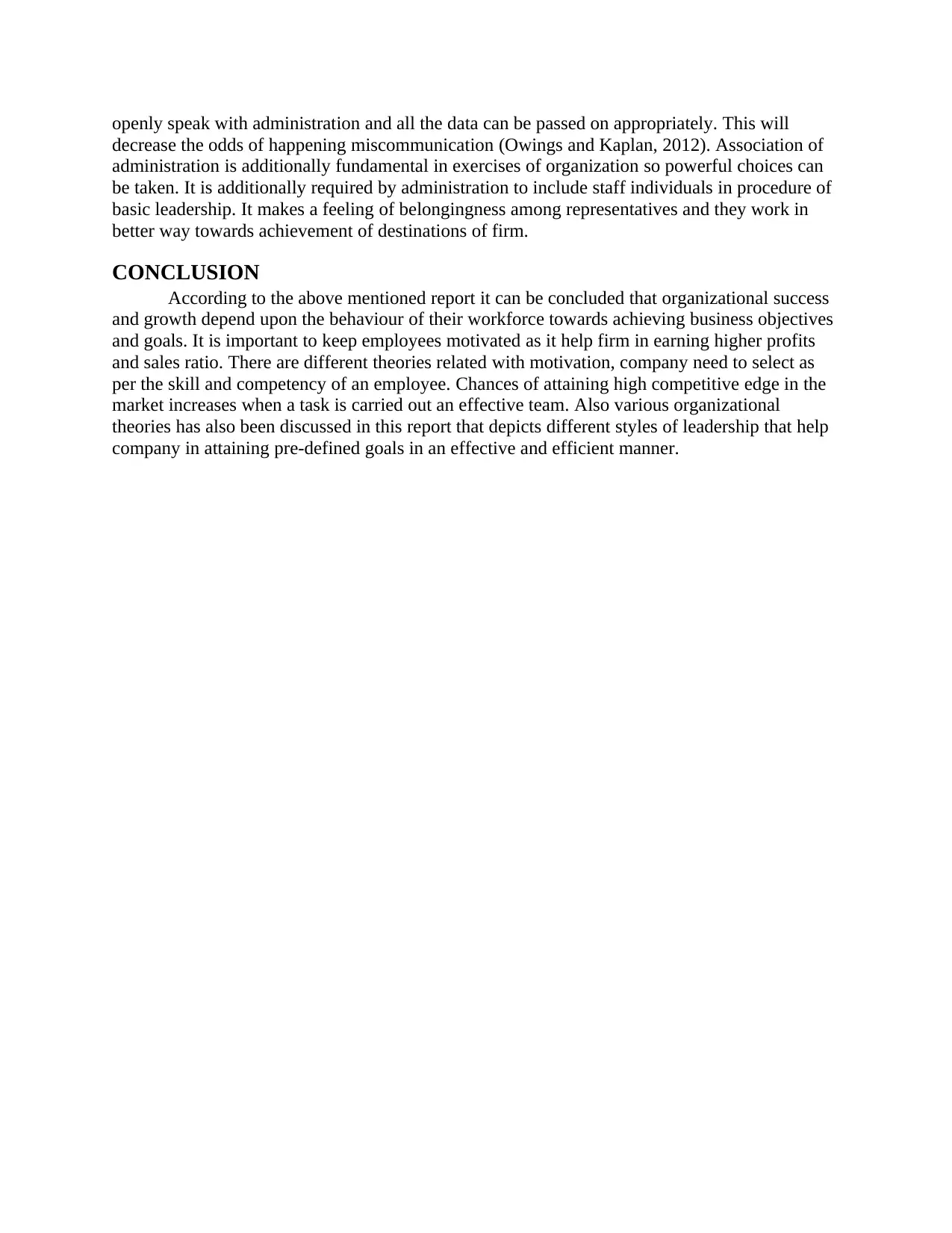
openly speak with administration and all the data can be passed on appropriately. This will
decrease the odds of happening miscommunication (Owings and Kaplan, 2012). Association of
administration is additionally fundamental in exercises of organization so powerful choices can
be taken. It is additionally required by administration to include staff individuals in procedure of
basic leadership. It makes a feeling of belongingness among representatives and they work in
better way towards achievement of destinations of firm.
CONCLUSION
According to the above mentioned report it can be concluded that organizational success
and growth depend upon the behaviour of their workforce towards achieving business objectives
and goals. It is important to keep employees motivated as it help firm in earning higher profits
and sales ratio. There are different theories related with motivation, company need to select as
per the skill and competency of an employee. Chances of attaining high competitive edge in the
market increases when a task is carried out an effective team. Also various organizational
theories has also been discussed in this report that depicts different styles of leadership that help
company in attaining pre-defined goals in an effective and efficient manner.
decrease the odds of happening miscommunication (Owings and Kaplan, 2012). Association of
administration is additionally fundamental in exercises of organization so powerful choices can
be taken. It is additionally required by administration to include staff individuals in procedure of
basic leadership. It makes a feeling of belongingness among representatives and they work in
better way towards achievement of destinations of firm.
CONCLUSION
According to the above mentioned report it can be concluded that organizational success
and growth depend upon the behaviour of their workforce towards achieving business objectives
and goals. It is important to keep employees motivated as it help firm in earning higher profits
and sales ratio. There are different theories related with motivation, company need to select as
per the skill and competency of an employee. Chances of attaining high competitive edge in the
market increases when a task is carried out an effective team. Also various organizational
theories has also been discussed in this report that depicts different styles of leadership that help
company in attaining pre-defined goals in an effective and efficient manner.
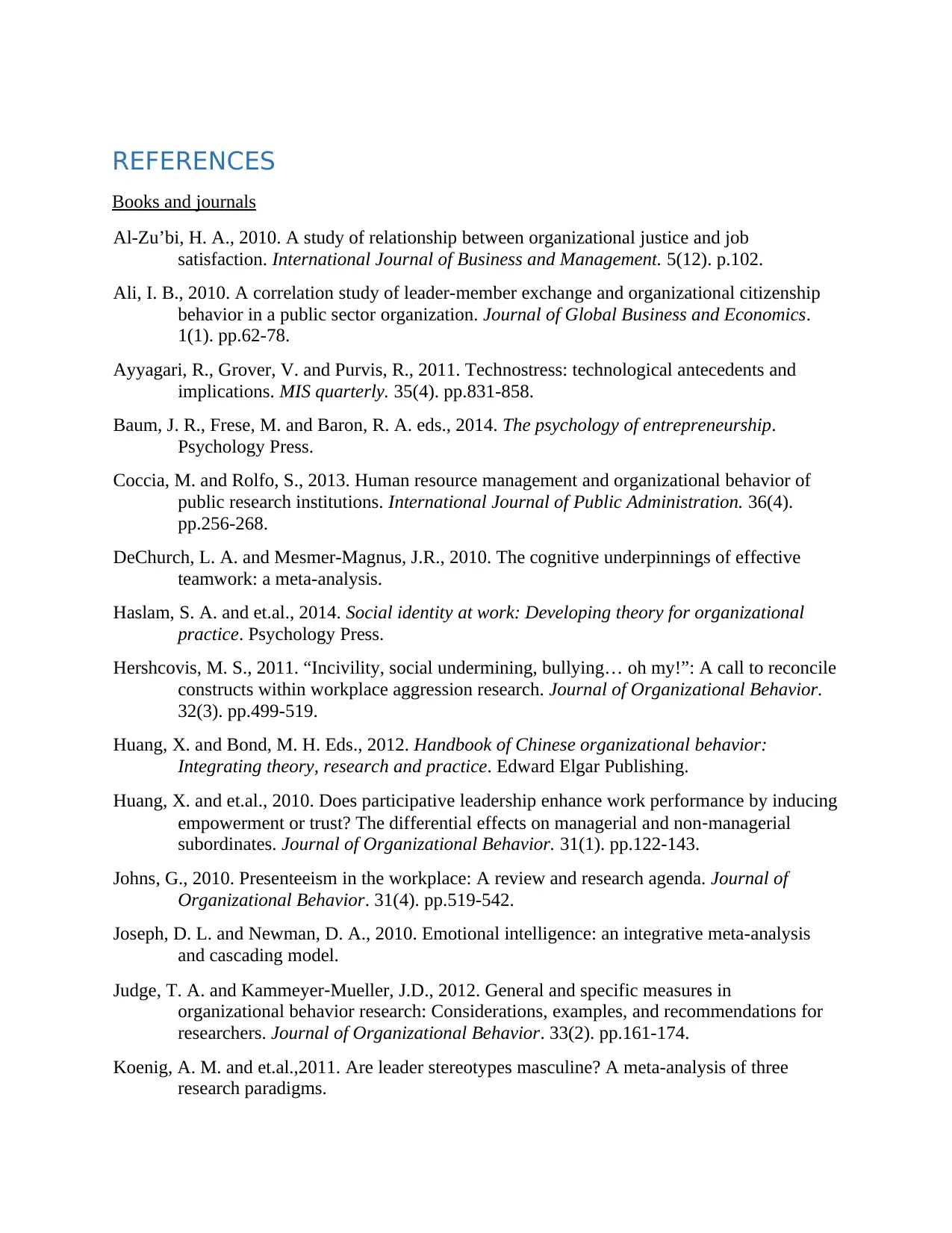
REFERENCES
Books and journals
Al-Zu’bi, H. A., 2010. A study of relationship between organizational justice and job
satisfaction. International Journal of Business and Management. 5(12). p.102.
Ali, I. B., 2010. A correlation study of leader-member exchange and organizational citizenship
behavior in a public sector organization. Journal of Global Business and Economics.
1(1). pp.62-78.
Ayyagari, R., Grover, V. and Purvis, R., 2011. Technostress: technological antecedents and
implications. MIS quarterly. 35(4). pp.831-858.
Baum, J. R., Frese, M. and Baron, R. A. eds., 2014. The psychology of entrepreneurship.
Psychology Press.
Coccia, M. and Rolfo, S., 2013. Human resource management and organizational behavior of
public research institutions. International Journal of Public Administration. 36(4).
pp.256-268.
DeChurch, L. A. and Mesmer-Magnus, J.R., 2010. The cognitive underpinnings of effective
teamwork: a meta-analysis.
Haslam, S. A. and et.al., 2014. Social identity at work: Developing theory for organizational
practice. Psychology Press.
Hershcovis, M. S., 2011. “Incivility, social undermining, bullying… oh my!”: A call to reconcile
constructs within workplace aggression research. Journal of Organizational Behavior.
32(3). pp.499-519.
Huang, X. and Bond, M. H. Eds., 2012. Handbook of Chinese organizational behavior:
Integrating theory, research and practice. Edward Elgar Publishing.
Huang, X. and et.al., 2010. Does participative leadership enhance work performance by inducing
empowerment or trust? The differential effects on managerial and non‐managerial
subordinates. Journal of Organizational Behavior. 31(1). pp.122-143.
Johns, G., 2010. Presenteeism in the workplace: A review and research agenda. Journal of
Organizational Behavior. 31(4). pp.519-542.
Joseph, D. L. and Newman, D. A., 2010. Emotional intelligence: an integrative meta-analysis
and cascading model.
Judge, T. A. and Kammeyer‐Mueller, J.D., 2012. General and specific measures in
organizational behavior research: Considerations, examples, and recommendations for
researchers. Journal of Organizational Behavior. 33(2). pp.161-174.
Koenig, A. M. and et.al.,2011. Are leader stereotypes masculine? A meta-analysis of three
research paradigms.
Books and journals
Al-Zu’bi, H. A., 2010. A study of relationship between organizational justice and job
satisfaction. International Journal of Business and Management. 5(12). p.102.
Ali, I. B., 2010. A correlation study of leader-member exchange and organizational citizenship
behavior in a public sector organization. Journal of Global Business and Economics.
1(1). pp.62-78.
Ayyagari, R., Grover, V. and Purvis, R., 2011. Technostress: technological antecedents and
implications. MIS quarterly. 35(4). pp.831-858.
Baum, J. R., Frese, M. and Baron, R. A. eds., 2014. The psychology of entrepreneurship.
Psychology Press.
Coccia, M. and Rolfo, S., 2013. Human resource management and organizational behavior of
public research institutions. International Journal of Public Administration. 36(4).
pp.256-268.
DeChurch, L. A. and Mesmer-Magnus, J.R., 2010. The cognitive underpinnings of effective
teamwork: a meta-analysis.
Haslam, S. A. and et.al., 2014. Social identity at work: Developing theory for organizational
practice. Psychology Press.
Hershcovis, M. S., 2011. “Incivility, social undermining, bullying… oh my!”: A call to reconcile
constructs within workplace aggression research. Journal of Organizational Behavior.
32(3). pp.499-519.
Huang, X. and Bond, M. H. Eds., 2012. Handbook of Chinese organizational behavior:
Integrating theory, research and practice. Edward Elgar Publishing.
Huang, X. and et.al., 2010. Does participative leadership enhance work performance by inducing
empowerment or trust? The differential effects on managerial and non‐managerial
subordinates. Journal of Organizational Behavior. 31(1). pp.122-143.
Johns, G., 2010. Presenteeism in the workplace: A review and research agenda. Journal of
Organizational Behavior. 31(4). pp.519-542.
Joseph, D. L. and Newman, D. A., 2010. Emotional intelligence: an integrative meta-analysis
and cascading model.
Judge, T. A. and Kammeyer‐Mueller, J.D., 2012. General and specific measures in
organizational behavior research: Considerations, examples, and recommendations for
researchers. Journal of Organizational Behavior. 33(2). pp.161-174.
Koenig, A. M. and et.al.,2011. Are leader stereotypes masculine? A meta-analysis of three
research paradigms.
⊘ This is a preview!⊘
Do you want full access?
Subscribe today to unlock all pages.

Trusted by 1+ million students worldwide
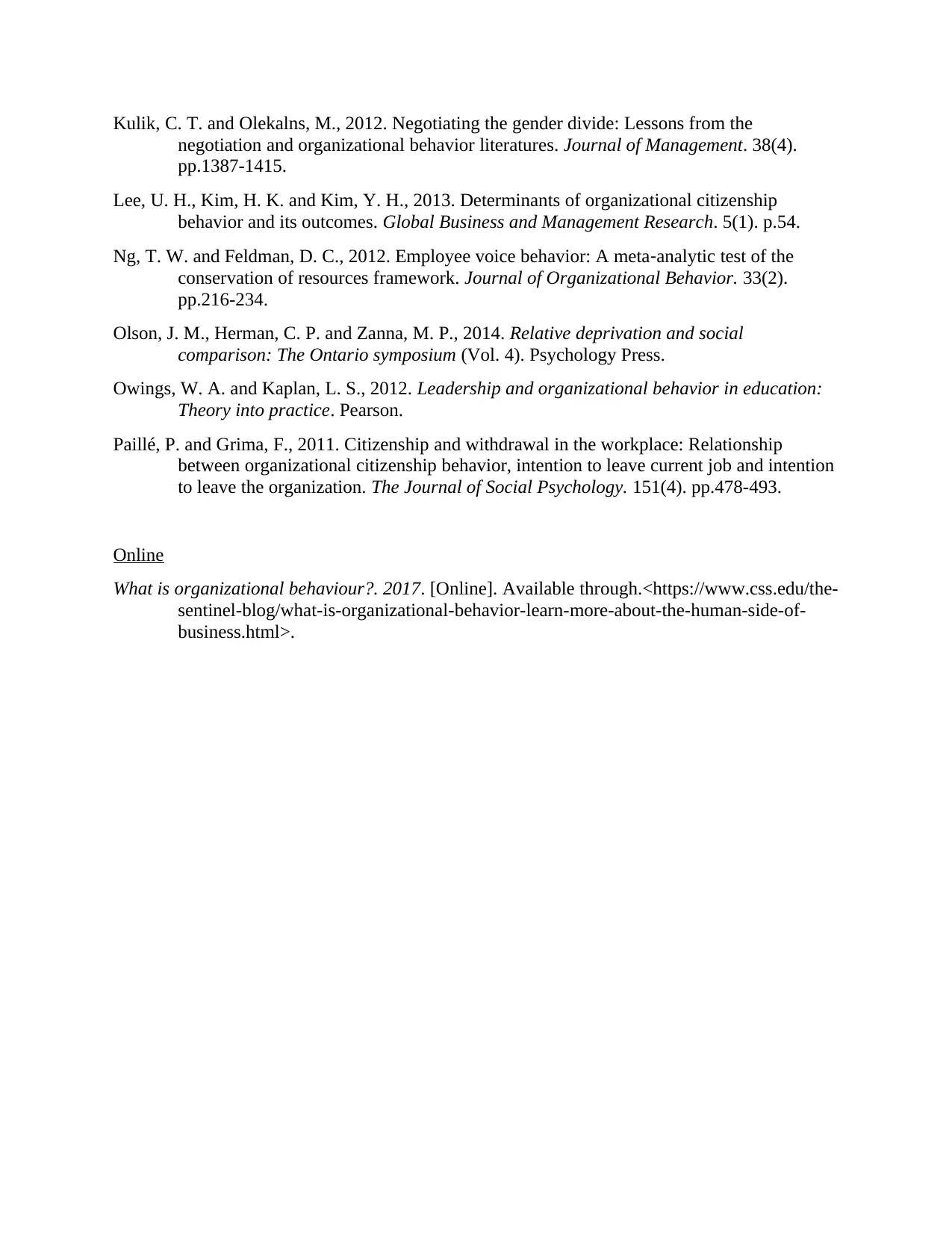
Kulik, C. T. and Olekalns, M., 2012. Negotiating the gender divide: Lessons from the
negotiation and organizational behavior literatures. Journal of Management. 38(4).
pp.1387-1415.
Lee, U. H., Kim, H. K. and Kim, Y. H., 2013. Determinants of organizational citizenship
behavior and its outcomes. Global Business and Management Research. 5(1). p.54.
Ng, T. W. and Feldman, D. C., 2012. Employee voice behavior: A meta‐analytic test of the
conservation of resources framework. Journal of Organizational Behavior. 33(2).
pp.216-234.
Olson, J. M., Herman, C. P. and Zanna, M. P., 2014. Relative deprivation and social
comparison: The Ontario symposium (Vol. 4). Psychology Press.
Owings, W. A. and Kaplan, L. S., 2012. Leadership and organizational behavior in education:
Theory into practice. Pearson.
Paillé, P. and Grima, F., 2011. Citizenship and withdrawal in the workplace: Relationship
between organizational citizenship behavior, intention to leave current job and intention
to leave the organization. The Journal of Social Psychology. 151(4). pp.478-493.
Online
What is organizational behaviour?. 2017. [Online]. Available through.<https://www.css.edu/the-
sentinel-blog/what-is-organizational-behavior-learn-more-about-the-human-side-of-
business.html>.
negotiation and organizational behavior literatures. Journal of Management. 38(4).
pp.1387-1415.
Lee, U. H., Kim, H. K. and Kim, Y. H., 2013. Determinants of organizational citizenship
behavior and its outcomes. Global Business and Management Research. 5(1). p.54.
Ng, T. W. and Feldman, D. C., 2012. Employee voice behavior: A meta‐analytic test of the
conservation of resources framework. Journal of Organizational Behavior. 33(2).
pp.216-234.
Olson, J. M., Herman, C. P. and Zanna, M. P., 2014. Relative deprivation and social
comparison: The Ontario symposium (Vol. 4). Psychology Press.
Owings, W. A. and Kaplan, L. S., 2012. Leadership and organizational behavior in education:
Theory into practice. Pearson.
Paillé, P. and Grima, F., 2011. Citizenship and withdrawal in the workplace: Relationship
between organizational citizenship behavior, intention to leave current job and intention
to leave the organization. The Journal of Social Psychology. 151(4). pp.478-493.
Online
What is organizational behaviour?. 2017. [Online]. Available through.<https://www.css.edu/the-
sentinel-blog/what-is-organizational-behavior-learn-more-about-the-human-side-of-
business.html>.
1 out of 10
Related Documents
Your All-in-One AI-Powered Toolkit for Academic Success.
+13062052269
info@desklib.com
Available 24*7 on WhatsApp / Email
![[object Object]](/_next/static/media/star-bottom.7253800d.svg)
Unlock your academic potential
Copyright © 2020–2025 A2Z Services. All Rights Reserved. Developed and managed by ZUCOL.





